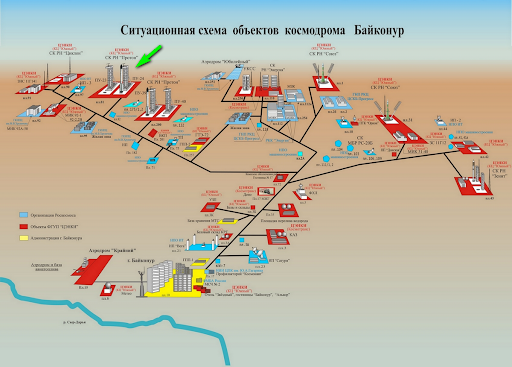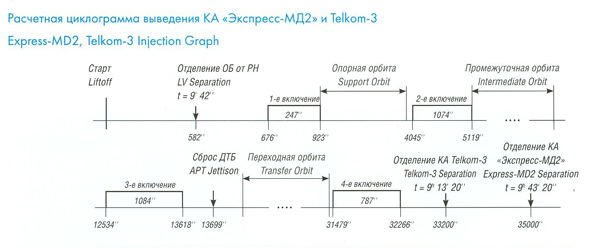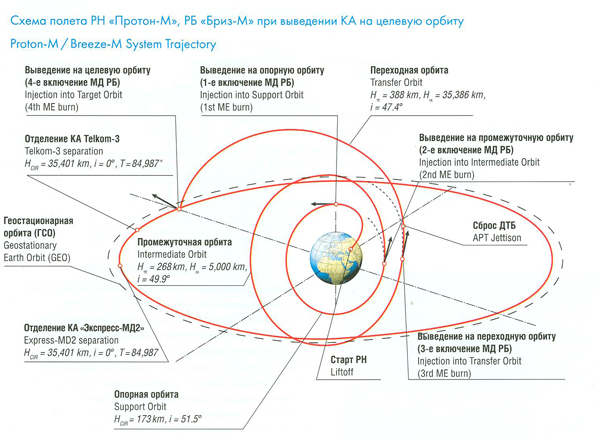In the midst of the crazy celebrations of the touchdown of Curiosity at Gale crater, the Russians were probably the ones left out in the air (though interestingly they do have one instrument on board Curiosity!). They, however, have a little show of their own today, with a Proton-M rocket getting ready to lift two Russian built communication satellites into orbit, one for the largest tele-com company in Indonesia and another for domestic use. So here are the details....



Launch location:
Baikonur Launch pad no. 81/24 46°4'15.38"N, 62°59'5.11"E

Launch dates and times:
{colsp=6}Launch times
Time Zone |
{colsp=6}
Live Coverage Of The Launch:
PAYLOAD 1
Telkom 3 communication satellite:

Mission Summary
In December 2008, JSC Academician M.F. Reshetnev “Information satellite systems” won a tender on IOD Scheme delivery of a geostationary telecommunication satellite system TELKOM 3 for the Indonesian operator PT Telekomunikasi Indonesia Tbk.
The project covers a development and in-orbit delivery of a satellite TELKOM 3, creation of augmented ground control segment, training, internship and technical support to the service operator during the satellite operation life. The satellite will be built based on a new medium-class platform «Ekspress-1000N». It will carry 32 C-band transponders and 10 Ku-transponders or equivalent to 49 TPE. The satellite TELKOM 3 mass will be 1600 kg, payload power – 5.6 kW, lifetime – 15 years. The satellite shall be manufactured and launched into the orbit in the middle of 2011.
The satellite will be built for one of the major telecommunication provider of the Asia-Pacific Region - PT Telekomunikasi Indonesia Tbk. For the tender, the main competitors of the Reshetnev company were well-known companies Orbital Sciences, Thales Alenia Space and Space Systems/Loral.
{colsp=2}Summary
Parameter | Value
Characteristics|
|

PAYLOAD 2
Express MD-2 communication satellite:

Mission Summary
Russian Satellite Communications Company has signed in 2006 a contract with Alcatel Alenia Space Italia and Khrunichev State Research and Production Space Centre to provide telecommunication payloads for Ekspress-MD1 and Ekspress-MD2 satellites.
Russian Satellite Communications Company (RSCC) signed a contract with Alcatel Alenia Space Italia to provide telecommunication payloads for the Ekspress MD-1 and Ekspress MD-2 satellites. The space bus will be built by Khrunichev State Research and Production Space Centre.
Ekspress MD-1 and MD-2 will each be equipped with eight C-band and one L-band transponders, along with a repeater panel and an antenna farm, to provide broadcasting and communications services across Russia and the CIS countries, as well as mobile presidential and governmental communications.
The payloads will be produced by Alcatel Alenia Space Italia (now Thales Alenia) and transferred to Khrunichev State Research and Production Space Centre for integration with the space bus in the third quarter of 2007. Express MD-1 was launched from Baikonur in 2009 jointly with the Ekspress-AM 44 satellite.
The new Express-MD1 and Express-MD2 satellites in orbit will allow RSCC to pursue a more flexible marketing policy on developing the satellite business, including the existing network backup, and to offer advanced communications and broadcasting services both in Russia and abroad.
{colsp=2}Summary
Parameter | Value
Characteristics|
|

Launch Vehicle:
{colsp=2}Characteristics
 |
|
{colsp=2}

The vehicle's reliability statistics according to http://www.spacelaunchreport.com/log2012.html#rate:
Proton-M Ascent Profile
The Proton-M first three stages place the orbital unit (OU), which consists of a Breeze-M upper stage, adapter system and the two satellites, into a 51.5° inclination suborbital trajectory.
Proton-M powered flight lasts 582 seconds. The OU powered flight begins at the moment of the third stage separation.

Immediately after the separation of the third stage booster, the Breeze-M stability engines start, damping the angular velocities of the third stage separation and then providing orbital unit orientation and stability during coast flight along a suborbital trajectory to await the first burn. The upper stage follows a five-burn injection profile.

Telkom-3/Express MD-2 Ascent Timeline
Event|Time rel lift-off|Time UTC|Comment
Ignition Start Sequence|-00:00:02.5|19:30:57.5 (August 6th)|
Stage 1 Ignition (40% thrust)|-00:00:01.75|19:30:58.25|
Command Stage 1 (100% thrust)|-00:00:00.9|19:30:59.1|
Maximum Dynamic Pressure|00:01:02|19:32:02|
1st/2nd Stage Separation|00:02:00|19:33:00|
2nd/3rd Stage Separation|00:05:28|19:36:28|
Payload Fairing Separation|00:05:47|19:36:47|
3rd Stage/Breeze M Separation|00:09:42|19:40:42|
1st Burn Ignition|00:11:16|19:42:16|
1st Burn Shutdown|00:15:23|19:46:23|1st Burn's Duration 00:04:07
2nd Burn Ignition|01:07:25|20:38:25|
2nd Burn Shutdown|01:25:19|20:56:19|2nd Burn's Duration 00:17:54
3rd Burn Ignition|03:28:54|22:59:54|
3rd Burn Shutdown|03:46:58|23:17:58|3rd Burn's Duration 00:18:04
APT Jettison|03:48:19|23:19:19|
4th Burn Ignition|08:44:39|04:15:39 (August 7th)|
4th Burn Shutdown|08:57:46|04:28:46|4th Burn's Duration 00:13:07
Telkom 3 Separation|09:13:20|04:44:20|
Express MD-2 Separation|09:43:20|05:14:20|
Weather forecast for Baikonur, Kazakhstan on August 7, 2012 (1 a.m.)
Clear. Low of 19C. Breezy. Winds from the NE at 15 to 25 km/h.
References
http://www.federalspace.ru
http://tvroscosmos.ru
http://www.khrunichev.ru
http://tihiy.fromru.com/Rn/RN_Proton.htm
http://space.skyrocket.de
http://www.tsenki.com
http://forum.nasaspaceflight.com
http://www.novosti-kosmonavtiki.ru
http://www.spacelaunchreport.com
http://english.wunderground.com/cgi-bin/findweather/getForecast?query=44.84999847,65.50000000


Launch location:
Baikonur Launch pad no. 81/24 46°4'15.38"N, 62°59'5.11"E

Launch dates and times:
Time Zone |
Baikonur / UTC+6
|
Moscow / UTC+4
|
Universal / UTC
|
Washington / EDT
|
Los Angeles / PDT
Launch time (Primary):
|
01:31:00
|
23:31:00
|
19:31:00
|
15:31:00
|
12:31:00
on:
|
Aug. 7, 2012
|
Aug. 6, 2012
|
Aug. 6, 2012
|
Aug. 6, 2012
|
Aug. 6, 2012
{colsp=6}
[highlight][eventTimer]2012-08-06 19:31:00?before|after;%dd% Days %hh% Hours %mm% Minutes %ss% Seconds %c%[/eventTimer] Telkom-3 and Express MD-2 Launch[/highlight]
Live Coverage Of The Launch:
- TSENKI Video Streams: http://www.tv-tsenki.com/livechoose.php
- Khrunichev COOPI (login: ? password: ?): http://coopi.khrunichev.ru/main.php?id=200
- Owners of PDA can watch the launch in test mode on: http://www.space-center.ru
PAYLOAD 1
Telkom 3 communication satellite:

Mission Summary
In December 2008, JSC Academician M.F. Reshetnev “Information satellite systems” won a tender on IOD Scheme delivery of a geostationary telecommunication satellite system TELKOM 3 for the Indonesian operator PT Telekomunikasi Indonesia Tbk.
The project covers a development and in-orbit delivery of a satellite TELKOM 3, creation of augmented ground control segment, training, internship and technical support to the service operator during the satellite operation life. The satellite will be built based on a new medium-class platform «Ekspress-1000N». It will carry 32 C-band transponders and 10 Ku-transponders or equivalent to 49 TPE. The satellite TELKOM 3 mass will be 1600 kg, payload power – 5.6 kW, lifetime – 15 years. The satellite shall be manufactured and launched into the orbit in the middle of 2011.
The satellite will be built for one of the major telecommunication provider of the Asia-Pacific Region - PT Telekomunikasi Indonesia Tbk. For the tender, the main competitors of the Reshetnev company were well-known companies Orbital Sciences, Thales Alenia Space and Space Systems/Loral.
Parameter | Value
Working Orbit:
|
GEO
Orbital Location:
|
118° East
Coverage:
|
South-East Asia
ApA at separation:
|
35401 km
PeA at separation:
|
35401 km
Inc at separation:
|
0°Telkom 3
Customer:
|- Telkom Indonesia
Prime contractor:
|- JSC Information Satellite Systems

Platform:
|- Express-1000N
Mass at Separation:
|- 1903 kg
Dry Mass:
|- ?
Stabilization:
|- 3 axis stabilized
Dimensions (stowed):
|- ?
Batteries:
|- ?
Payload:
|- 10 C-band transponders
- 32 Ku-band transponders
Life time:
|- 15 years
Ku-band coverage:
|- ? (can somebody help?)
C-band coverage:
|- ? (can somebody help?)
|
PAYLOAD 2
Express MD-2 communication satellite:

Mission Summary
Russian Satellite Communications Company has signed in 2006 a contract with Alcatel Alenia Space Italia and Khrunichev State Research and Production Space Centre to provide telecommunication payloads for Ekspress-MD1 and Ekspress-MD2 satellites.
Russian Satellite Communications Company (RSCC) signed a contract with Alcatel Alenia Space Italia to provide telecommunication payloads for the Ekspress MD-1 and Ekspress MD-2 satellites. The space bus will be built by Khrunichev State Research and Production Space Centre.
Ekspress MD-1 and MD-2 will each be equipped with eight C-band and one L-band transponders, along with a repeater panel and an antenna farm, to provide broadcasting and communications services across Russia and the CIS countries, as well as mobile presidential and governmental communications.
The payloads will be produced by Alcatel Alenia Space Italia (now Thales Alenia) and transferred to Khrunichev State Research and Production Space Centre for integration with the space bus in the third quarter of 2007. Express MD-1 was launched from Baikonur in 2009 jointly with the Ekspress-AM 44 satellite.
The new Express-MD1 and Express-MD2 satellites in orbit will allow RSCC to pursue a more flexible marketing policy on developing the satellite business, including the existing network backup, and to offer advanced communications and broadcasting services both in Russia and abroad.
Parameter | Value
Working Orbit:
|
GEO
Orbital Location:
|
145° East
Coverage:
|
Siberia/Far-eastern Russia
ApA at separation:
|
35401 km
PeA at separation:
|
35401 km
Inc at separation:
|
0°Express MD-2
Customer:
|- Russian Satellite Communications Company

Prime contractor:
|- Khrunichev State Research and Production Space Centre

Platform:
|- modified Yakhta bus
Mass at Separation:
|- 1140 kg
Dry Mass:
|- ?
Stabilization:
|- 3 axis stabilized
Dimensions (stowed):
|- ?
Batteries:
|- ?
Payload:
|- 8 C-band transponders
- 1 L-band transponder
Life time:
|- 10 years
C-band coverage:
||

Launch Vehicle:

Proton-M / Briz-M
Prime contractor:
|- Khrunichev Space Centre

GRAU Index:
|- 8K82KM
Height:
| 58.2 m with upper stage and payload fairingDiameter:
| max 7.4 mLiftoff mass:
| 705 metric tonnesPayload mass:
| ~22 tonnes at LEO1st stage:
|- 6 X RD-275 engines
- Empty 30.6 tonnes
- Propellants 419.41 tonnes (UDMH and NTO)
- Thrust in vacuum 1069.8 tonnes of force
- Thrust at sea level 971.4 tonnes of force
2nd stage:
|- 1 X RD-0211 engine 3 X RD-0210 engines
- Empty 11.4 tonnes
- Propellants 156.113 tonnes (UDMH and NTO)
- Thrust in vacuum 237.4 tonnes of force
3rd stage:
|- 1 X RD-0213 engine & 1 X RD-0214 vernier engine
- Empty 3.7 tonnes
- Propellants 46.562 tonnes (UDMH and NTO)
- Thrust in vacuum 59.36 (core) + 3.15 (vernier) tonnes of force
Upper Stage:
|

- GRAU Index: 14S43
- Common Name: Briz-M
- Designer & Manufacturer: Khrunichev Space Centre
- Dimensions: Length 2.654 m, Diameter 4 m
- Empty Mass 2.2 tonnes
- Propellants 6 660 kg UDMH + 13 260 kg N2O4
- Flight time: no less than 24 hours
- Main Engine: 1 X 14D30
- Thrust in vacuum 2.0 tonnes of force
- ISP 328.6 s
- Main engine restarts: up to 8 times
- Precision Manoeuvering Engines: 4 X 11D458
- Thrust in vacuum 400 N each
- ISP 252 s
- RCS Engines: 12 X 17D58E
- Thrust in vacuum 13.3 N each
- ISP 274 s
Payload Fairing:
|- Diameter 4.35 m
- Length 11.6 m
The vehicle's reliability statistics according to http://www.spacelaunchreport.com/log2012.html#rate:
Code:
================================================================
Vehicle Successes/Tries Realzd Pred Consc. Last Dates
Rate Rate* Succes Fail
================================================================
Proton-M/Briz-M 53 57 .93 .92 11 08/17/11 2001-Proton-M Ascent Profile
The Proton-M first three stages place the orbital unit (OU), which consists of a Breeze-M upper stage, adapter system and the two satellites, into a 51.5° inclination suborbital trajectory.
Proton-M powered flight lasts 582 seconds. The OU powered flight begins at the moment of the third stage separation.

Immediately after the separation of the third stage booster, the Breeze-M stability engines start, damping the angular velocities of the third stage separation and then providing orbital unit orientation and stability during coast flight along a suborbital trajectory to await the first burn. The upper stage follows a five-burn injection profile.

Telkom-3/Express MD-2 Ascent Timeline
Ignition Start Sequence|-00:00:02.5|19:30:57.5 (August 6th)|
Stage 1 Ignition (40% thrust)|-00:00:01.75|19:30:58.25|
Command Stage 1 (100% thrust)|-00:00:00.9|19:30:59.1|
Maximum Dynamic Pressure|00:01:02|19:32:02|
1st/2nd Stage Separation|00:02:00|19:33:00|
2nd/3rd Stage Separation|00:05:28|19:36:28|
Payload Fairing Separation|00:05:47|19:36:47|
3rd Stage/Breeze M Separation|00:09:42|19:40:42|
1st Burn Ignition|00:11:16|19:42:16|
1st Burn Shutdown|00:15:23|19:46:23|1st Burn's Duration 00:04:07
2nd Burn Ignition|01:07:25|20:38:25|
2nd Burn Shutdown|01:25:19|20:56:19|2nd Burn's Duration 00:17:54
3rd Burn Ignition|03:28:54|22:59:54|
3rd Burn Shutdown|03:46:58|23:17:58|3rd Burn's Duration 00:18:04
APT Jettison|03:48:19|23:19:19|
4th Burn Ignition|08:44:39|04:15:39 (August 7th)|
4th Burn Shutdown|08:57:46|04:28:46|4th Burn's Duration 00:13:07
Telkom 3 Separation|09:13:20|04:44:20|
Express MD-2 Separation|09:43:20|05:14:20|
Weather forecast for Baikonur, Kazakhstan on August 7, 2012 (1 a.m.)
Clear. Low of 19C. Breezy. Winds from the NE at 15 to 25 km/h.
References
http://www.federalspace.ru
http://tvroscosmos.ru
http://www.khrunichev.ru
http://tihiy.fromru.com/Rn/RN_Proton.htm
http://space.skyrocket.de
http://www.tsenki.com
http://forum.nasaspaceflight.com
http://www.novosti-kosmonavtiki.ru
http://www.spacelaunchreport.com
http://english.wunderground.com/cgi-bin/findweather/getForecast?query=44.84999847,65.50000000
Last edited:










